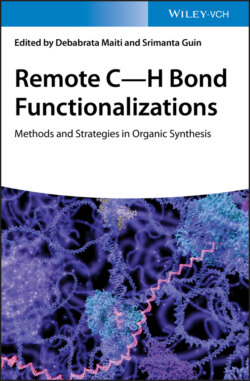Читать книгу Remote C-H Bond Functionalizations - Группа авторов - Страница 22
2.2.6 Alcohol Derivatives
ОглавлениеAlcohols are important organic compounds widely found in many drug molecules. In 2013, Tan and coworkers reported a meta‐C–H olefination of benzyl alcohols by using an effective bulky di‐isopropyl silyl ether tethered nitrile‐based template (Scheme 2.51) [48]. The template could be easily attached to the benzyl alcohol substrates and readily cleaved in situ with tetrabutylammonium fluoride (TBAF) under mild conditions, making the approach synthetically practical. Using the MPAA ligand Ac‐Gly‐OH in the presence of HFIP, a range of benzyl alcohols were meta‐olefinated smoothly with all substitution patterns on the aromatic ring. Moreover, the template was applicable to both primary and secondary alcohols with equal efficacy.
Scheme 2.51 meta‐C–H olefination of benzyl alcohols.
Source: Modified from Lee et al. [48].
To expand the potential of achieving site selectivity in C–H activation via the recognition of distal and geometric relationship between existing chelating groups and CH bonds of similar reactivity in organic molecules, Yu and coworkers engineered the first pyridine‐based directing template that was effective for meta‐C–H olefination of benzyl and phenyl ethyl alcohols (Scheme 2.52) [49]. This remarkable breakthrough is impressive, since the pyridyl group has only been extensively utilized to assist the ortho‐CH bond activation previously. Notably, this novel template also enabled a new meta‐C–H iodination reaction by using DIH as the iodination reagent, which was not feasible with nitrile‐based directing templates previously (Scheme 2.53). The aryl iodide products are synthetically useful intermediates, since they are amenable to a wide range of transformations such as the transition‐metal‐catalyzed cross‐coupling reactions.
Scheme 2.52 meta‐C–H olefination of benzyl and phenyl ethyl alcohols.
Source: Modified from Chu et al. [49].
Scheme 2.53 meta‐C–H iodination of benzyl and phenylethyl alcohols.
In 2017, Xu, Jin, and coworkers reported a Pd‐catalyzed remote meta‐C–H olefination of a wide range of arene‐tethered alcohols such as 2‐phenylethyl, 3‐phenylpropyl alcohols, and their long‐chain homologues (Scheme 2.54) [50]. This protocol would be potentially useful for late‐stage modification and post‐synthetic diversification of biologically active molecules for drug discovery. Density functional theory (DFT) computational studies were also performed to reveal that regioselectivity of this reaction resulted from both the C–N–Ag angles and gauche conformations of phenyl ether play.
Scheme 2.54 meta‐C–H olefination of distal arene‐tethered alcohols.
Source: Modified from Zhang et al. [50].
Subsequently, by using a different pyrimidine‐based template that was used for meta‐C–H cyanation of phenyl ethyl alcohols [41], Jayarajan, Maiti, and coworkers achieved meta‐C–H functionalizations of conformationally flexible long‐chain arenes derived from alcohols (Scheme 2.55) [51]. The chain length could be up to 18 bonds between the target CH bond and the chelating nitrogen atom of the directing template. Remarkably, this approach enabled diverse functionalizations include olefination, alkylation, cyanation, and acetoxylation. Moreover, the template could be readily cleaved by using ceric ammonium nitrate (CAN) under mild conditions (Scheme 2.56). It is worth noting that when perfluoroolefins were used, meta‐C–H olefination was also feasible for these alcohol derivatives with different linker length under similar reaction conditions [24].
Scheme 2.55 meta‐C–H functionalizations of arenes with different linker lengths.
Source: Modified from Jayarajan et al. [51].
Scheme 2.56 Removal of the pyrimidine‐based template.
In 2019, Paton, Maiti, and coworkers developed the Palladium(II)‐catalyzed meta‐selective C–H allylation of alcohol derivatives using synthetically inert acyclic internal olefins as allylic surrogates, under the conditions discussed earlier for benzylsulfonyl esters (Scheme 2.57) [27]. Experimental and computational studies implied that the pyrimidine‐based directing group was crucial this meta‐selective C–H activation in determining the product selectivities. Notably, besides phenylethyl alcohols, alcohol derivatives with longer chain homologues could also be viable in this transformation.
Scheme 2.57 meta‐C–H allylation of alcohol derivatives.
Source: Modified from Achar et al. [27].
Recently, Wang, Kong, and coworkers developed the palladium‐catalyzed meta‐olefination of arene‐tethered diols assisted by a pyrimidine‐based template (Scheme 2.58) [52]. It was demonstrated this method could be used for the facile synthesis of various diol‐based natural products such as coumarins. Moreover, removal of the template was easily realized by hydrolysis under acidic conditions.
Scheme 2.58 meta‐C–H olefination of arene‐tethered diols.
Source: Modified from Fang et al. [52].
Finally, Yu, Dai, and coworkers also achieved meta‐C–H deuteration of benzyl and phenyl ethyl alcohols with a pyridine‐based template using easily available deuterium source such as deuterated acetic acid (Scheme 2.59) [19]. The template was linked to the substrate through a practical ester linkage that could be easily installed and cleaved. With high levels of D‐incorporation at the meta‐positions, this approach is potentially useful since deuterium‐labeled compounds are important for mechanistic and metabolic studies.
Scheme 2.59 meta‐C–H deuteration of alcohols.
Source: Modified from Xu et al. [19].
